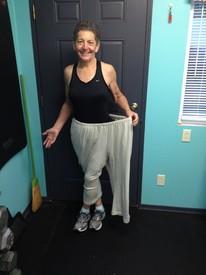Scale readings depending on level of activity?

irenesalor
Posts: 97 Member
Just out of curiosity:
For scales which have an option to measure body composition, does anybody know why the readings for body fat are slightly inconsistent when you change your activity level setting?
i.e. - if I weigh myself in the same exact circumstances, but change the activity level setting on my scale from moderate exercise to light exercise, there can be >1% increase in body fat.
For scales which have an option to measure body composition, does anybody know why the readings for body fat are slightly inconsistent when you change your activity level setting?
i.e. - if I weigh myself in the same exact circumstances, but change the activity level setting on my scale from moderate exercise to light exercise, there can be >1% increase in body fat.
4
Replies
-
All scales BF% are wildly inaccurate. The only thing they can do slightly is record a trend over a LONG period of time. Therefore, wouldn't worry about which setting to use, pick one and sit to it to do the trend. The actual BF% is probably wrong anyway.7
-
The bf readings on these scales are known to be wildly inconsistent. My guess is that the formula is set up in a way that “assumes” the more active someone is, the lower their bf.3
-
All scales BF% are wildly inaccurate. The only thing they can do slightly is record a trend over a LONG period of time. Therefore, wouldn't worry about which setting to use, pick one and sit to it to do the trend. The actual BF% is probably wrong anyway.
You're absolutely right. I definitely think I have a higher body fat than what the scale reads. I use it mostly to see if there are minor changes after each week (+/- 0.X% variations) and to make sure I keep most of my muscle mass.The bf readings on these scales are known to be wildly inconsistent. My guess is that the formula is set up in a way that “assumes” the more active someone is, the lower their bf.
That formula theory makes perfect sense!
Thank you both for your responses!
0 -
I've always been of the opinion that any reading you get from a home scale other than weight, is little more than a gimmick used to either make the scale seem more 'high tech' so you'll buy it over a more simple scale and/or to justify charging some pretty hefty prices.1
-
Maybe the formula accounts for estimated water retention, eg a light exerciser prob wont be carrying extra water for muscle repair with a moderate exerciser might carry some day to day.1
-
irenesalor wrote: »All scales BF% are wildly inaccurate. The only thing they can do slightly is record a trend over a LONG period of time. Therefore, wouldn't worry about which setting to use, pick one and sit to it to do the trend. The actual BF% is probably wrong anyway.
You're absolutely right. I definitely think I have a higher body fat than what the scale reads. I use it mostly to see if there are minor changes after each week (+/- 0.X% variations) and to make sure I keep most of my muscle mass.The bf readings on these scales are known to be wildly inconsistent. My guess is that the formula is set up in a way that “assumes” the more active someone is, the lower their bf.
That formula theory makes perfect sense!
Thank you both for your responses!
Oh, if the BF% is inaccurate - it's at least based on a reading and formula from studies.
The muscle mass is even worse, it's the non-BF leftover (Fat Free Mass- FFM, or LBM Lean Body Mass), and then statistical averages applied from your other physical stats for a wild estimate of what of the LBM was muscle compared to water compared to bone compared to ..... you get the point.
Muscle is merely 1 part of LBM (despite the terrible usage and confusion of that phrase) - so hoping any 1 reading there is of any value is much worse than even the BF% reading.
The active setting could be attempting to assist on deciding if the leg only measurement of the BIA should be skewed, or perhaps the water content reading, or other.
Dollars to donuts it's a custom tweak not supported by any studies.
And don't eat a donut before getting on it either!0
This discussion has been closed.
Categories
- All Categories
- 1.4M Health, Wellness and Goals
- 395.2K Introduce Yourself
- 44.1K Getting Started
- 260.6K Health and Weight Loss
- 176.2K Food and Nutrition
- 47.5K Recipes
- 232.7K Fitness and Exercise
- 446 Sleep, Mindfulness and Overall Wellness
- 6.5K Goal: Maintaining Weight
- 8.6K Goal: Gaining Weight and Body Building
- 153.2K Motivation and Support
- 8.2K Challenges
- 1.3K Debate Club
- 96.4K Chit-Chat
- 2.5K Fun and Games
- 4.2K MyFitnessPal Information
- 16 News and Announcements
- 1.3K Feature Suggestions and Ideas
- 2.9K MyFitnessPal Tech Support Questions




